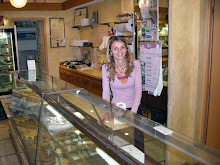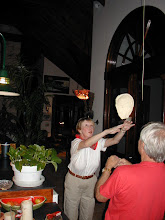Do you have a dream destination for dinner in a foreign city and if so, where would you choose? Paris perhaps or London, Rome or Madrid? I would probably choose Paris because it’s such a romantic city and the choices of fine dining are plentiful. But how about it if I shake it up a bit and ask what foreign city would you choose if your dream was to prepare dinner for a couple of your friends.
Without hesitation my first choice would be Saint-Remy-de-Provence in the South of France. It is a bit laid back compared to big cities, but that’s what is so charming about the villages of Provence. In fact we are in the process of putting the finishing touches on our next trip there in the spring. St. Remy is in the Bouches-du-Rhône area of Provence in the Alpilles near Avignon, Arles and Aix-en-Provence and about an hour north of the old port city of Marseille. According to the local tourist department, St. Remy is bathed in sunshine for more than 300 days a year.
Since I chose to prepare dinner at home for some friends rather than dining out, it will encompass a bit of shopping. A natural choice for this dream dinner would be to serve a local Provençale Daube of Beef, accompanied by Le Macaronade, a macaroni gratin, and finish with simple dessert such as Julia Child’s cherry clafouti. Join me as we stop in St. Remy for a few things we’ll need.
Shopping in Provence is an adventure all into itself. There will be many stops along the way as you’ll see and everything is done in a leisurely style. Bring plenty of patience with you. I also suggest that you make sure to brush up on your French as many of the shop owners in small towns in Provence don’t speak English and if they do, it is un peu.
In fact if you’re game, I suggest you do a little research and write your grocery list in French. If I happen to look up a recipe on line and the directions aren't in English, I always find it easier if the website owner uses software to translate the website for me. While you’re doing your research, also jot down a few words and phrases that will help you as you shop. I guarantee it will be very helpful. I don’t speak French very well and I found that my written list came in very handy when my school girl pronunciation skills let me down as it often did. Contrary to what you’ve might have heard about the French, most all of them, especially in small villages, want to be very helpful, but it’s important that you do your part as well.
If we are to follow the lead of the locals, the first stop should always be the boulangerie for a freshly baked baguette, the first thing in the morning bien sur.
Tuck the baguette under your arm or put it in your straw shopping bag that you’ve brought along for the occasion. No straw shopping bag? No problem. There will be many to choose from at the local outdoor market in the square, where we’re off to next to pick up some assorted olives and nuts to munch on while we’ll sip a pastis, a popular aperitif in Provence, before dinner.
For the vegetables in our stew, we’ll stop at this lovely vegetable stand and also ask about local cherries for the clafouti.
Of course while we’re at the market we must pick up some flowers. Which ones do you like?
In Provence you never know what you might see at the local market. Perhaps a pet pour vous to take home?
Our final stop will be the boucherie for the meat for our daube. We’ll ask the butcher to choose the cut of beef for us while we chat with him about the weather.
As you can tell, shopping is a leisurely affair in Provence. Everyone must first be greeted with a friendly Bonjour Monsieur or Bonjour Madame as you enter their shop or approach their stall at the outdoor market and there’s always a polite au revoir or bonne journee exchanged as you depart. Oh, let’s not forget to pick up a couple of bottles of a local Cote de Rhone to serve with dinner while we’re out.
We’ve often said that if we had one more big dream left to follow it would be to live in Provence and perhaps find an old mas, the French word for farm house, to remodel. Unfortunately for us, we no longer have enough energy or youth to chase another dream. We already followed one big dream when we lived on a tiny private cay in the northern Bahamas for ten years. So now we visit Provence as often as we possibly can and rent someone else’s home for a couple of months and “pretend” we live there. Here’s our next “pretend” home for the coming spring just outside St. Remy-de-Provence.
When I was last in St. Remy I picked up some Les Olivades napkins at one of the local shops as one of the souvenirs of our trip. You’ll notice that I used them today when I set the table for dinner. Les Olivades is the last local company to continue the tradition of printing on fabric begun in Provence in Marseille in 1648 and they are still creating wonderful designs based on the original styles. Napkins and small things such as the local fleur de sel harvested in the nearby Camargue or charming burlap bags of herbs de Provence make nice gifts for yourself or your friends and they don’t take up any room at all in your suitcase.
The following recipe for daube looks very long, but if I were to leave out the details and the optional garnishes, it might read like this: combine all of the ingredients one day, cook them the next day, let them ripen one more day, spoon off any unwanted fat that rises to the surface, reheat, and eat. All this with only a single pot to wash.
Provençale Daube of Beef or Estouffade Provençale
Inspired by Cooking School Provence –by Guide Gedda & Bistro Cooking by Patricia Wells
Serves 6 to 8 and should be made two days before serving
Printable Recipe
2 ½ pounds beef, cut into 1 ½” chunks (a butcher can do this for you), we used boneless bottom round
2 medium mild onions, coarsely chopped
2 garlic cloves, peeled and crushed
1 large carrot, peeled and cut into ½” rounds
1 celery rib, minced
Kosher salt or sea salt and freshly ground black pepper
2 tablespoons extra-virgin olive oil
1 bottle (3 cups) red wine, preferably Provençale, I used a Cote de Rhone
¼ cup marc de Provence or Cognac
1 bunch of fresh thyme
3 imported bay leaves
4 cloves, wrapped in a bag of cheesecloth
About a ¼ teaspoon freshly grated nutmeg
1 strip of orange zest, about 2 inches, dried if desired (link to how to dry orange zest here)
As needed:
1 ounce baking chocolate, chopped
1 to 2 tablespoons local honey
A dash of red wine vinegar
Garnishes, optional:
More orange zest, chopped, for garnish
Fresh flat-leaf Italian parsley for garnish
Assorted fancy mushrooms, briefly sautéed in good butter & seasoned with sea salt and freshly ground black pepper
3 or 4 fresh carrots, peeled, par-boiled and sautéed in good butter until they begin to brown, then seasoned with sea salt and freshly ground black pepper.
Two days before serving the daube, combine all of the ingredients minus the garnishes in a large enameled casserole. Cover and refrigerate overnight. The next day, bring the mixture to a simmer over low heat. Simmer gently until the meat is very tender, about 3 to 4 hours. Allow to cool down and refrigerate until the fat rises to the top and can be easily scraped off with a small spoon, about 12 hours or overnight.
At serving time, scraping off any additional fat. Reheat until the meat is heated through, 10 to 15 minutes. Remove the thyme leaves, bay leaves, orange jest, and bag of cloves. Taste for seasonings and adjust accordingly. You may want to add the crumbled chocolate, honey and/or the vinegar if taste dictates. I added the chocolate and I thought it took away the slight bitterness of the sauce. If your sauce is too thin, see cook’s notes below on how to thicken with a beurre manié.
For garnishes, be sure to use freshly chopped flat-leaf parsley and chopped orange zest. Both bring an air of light freshness to the dish. If desired you can add additional garnishes, such as freshly sautéed fancy mushrooms and additional carrots.
If accompanied by a macaroni gratin (recipe below), be sure to reserve 1 cup of the sauce from the daube for the macaroni. Equally delicious is simple buttered noodles with grated Parmesan.
Cook’s notes: If your sauce is not thick enough (ours wasn’t), make a beurre manie by blending 3 T flour with 2 T softened butter to make a paste. Off heat, whisk in the beurre manié, then simmer the sauce for 2 minutes as it thickens. If you find your sauce is too tart (ours was), you can add some finely chopped good chocolate or a bit of honey and let it heat through the dish. I keep only dark chocolate on hand and honey, especially local, is a staple in any kitchen in Provence. If it needs a bit of spark, add a dash or two of red wine vinegar.
La Macaronade or Macaroni Gratin
Adapted from Bistro Cooking by Patricia Wells – serves 4
Printable Recipe
To prepare authentic macaronade, you must first prepare a stew, either an Estouffade or a Daube, the traditional beef stew of the south of France.
Kosher salt
1 pound elbow macaroni
1 cup liquid reserved from Provençale Beef Daube
1 cup freshly grated imported Parmesan cheese
Preheat the broiler. Bring a large pot of water to a rolling boil. Salt the water and add the pasta and cook until tender, then drain. Spoon half of the noodles in a 2 quart gratin dish or individual serving dishes. Moisten the noodles with half of the stew liquid. Sprinkle half of the cheese over the noodles, then add remaining noodles, liquid and cheese. Place under the broiler and broil just until the cheese is browned and sizzling.
Julia Child’s Cherry Clafouti a la Liqueur
Mastering the Art of French Cooking by Julia Child – serves 6
Printable Recipe
3 cups pitted black cherries
¼ cup cognac
1/3 cup granulated sugar
Batter:
Liquid from the cherries and enough milk to equal 1 ¼ cups
1/3 cup granulated sugar
3 eggs
1 Tablespoon vanilla extract
1/8 teaspoon salt
2/3 cup sifted all-purpose flour
An electric blender
A 7-8 cup lightly buttered, fireproof baking dish or Pyrex pie plate
Powdered sugar for garnish
Preheat oven to 350 degrees F. Use fresh, black, sweet cherries in season and let them stand for 1 hour in the cognac and sugar.
Place the batter ingredients in your blender jar in the order in which they are listed. Cover & blend at top speed for 1 minute. Pour a ¼” layer of batter in the lightly buttered baking dish or pie plate. Put in the oven to let the batter set. Spread the drained cherries over the batter, then pour on the rest of the batter and smooth the surface with the back of a spoon.
Place in middle position of preheated oven and bake for about an hour. It is done when it has puffed and browned and a needle or knife plunged into its center comes out clean. Sprinkle the top with powdered sugar just before bringing to the table. It need not be served hot, but should still be warm. It will sink down slightly as it cools.
Au revoir for now from Saint. Remy-de-Provence in the South of Provence.
For better viewing, click photos to enlarge.
This will be shared with Foodie Friday at Rattlebridge Farm, Miz Helen’s Country Kitchen Full Plate Thursday, and Weekend Bites at Simple Recipes.
Have a great weekend everyone.

























































